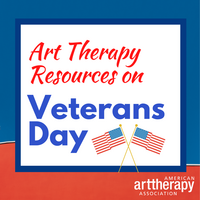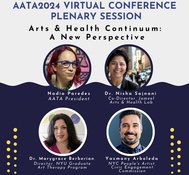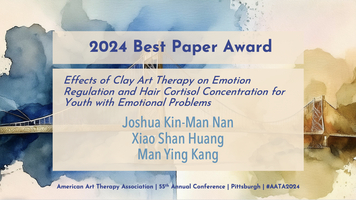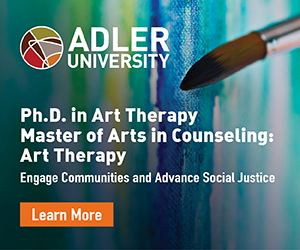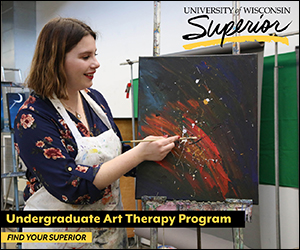 |
||||||||||||||||||||
| Archive | Subscribe | Advertise | arttherapy.org | ||||||||||||||||||||
While art interventions have long been used with veterans and service members, increases in mental health issues make it more important than ever to highlight the work art therapists do to support these communities and their families. A recent study by the Department of Veterans Affairs (VA) on the impact of suicide on women veterans in particular demands urgent attention. Between 2020 and 2021, the suicide rate among women veterans increased 24.1% — nearly four times higher than the 6.3% increase among male veterans and vastly higher than the 2.6% increase among non-veteran women. If you have a resource or related research you’d like to share before Nov. 11, please email us at info@arttherapy.org. If you’re an AATA member, join our Veterans Shared Interest Group.
From the White House to the World Health Organization, policy makers have begun pushing to integrate arts in physical health care, beyond mental health and well-being. During last weekend’s Virtual Conference, our plenary panelists discussed how the arts are emerging as the next frontier in overall health and well-being — beyond mental health. They examined how federal and local governments, healthcare systems, and cultural institutions are increasing their arts and wellness programming. Featuring AATA President Nadia Paredes; Dr. Nisha Sajnani, Director of the Jameel Arts & Health Lab; Dr. Marygrace Berberian, NYU Graduate Art Therapy Program Director and AATA Board Member; and Artist Yazmany Arboleda, New York City’s inaugural People’s Artist at the Civic Engagement Commission. This session was presented during the AATA2024 Virtual Conference, Oct. 26 - 27, and is now available at a special introductory rate of $34 for AATA Members and $54 for non-members. Attendees may receive 1.5 CE credits.
Did you miss last weekend’s SIG-apalooza? SIGs, short for Shared Interest Groups, were created to help art therapists find community at AATA conferences – and year-round through the MyAATA Member Community. SIGs are led by AATA members to facilitate connection and build a space for art therapists to support each other. Many of you have asked how to join a SIG. A good place to start is the MyAATA community. AATA Members are welcome to join a SIG according to your interests and based on how you personally identify. → Art → Disability Advocacy → International → LGBTQIA++/Queer → Medical Settings → Neuroscience → Older Adults → Private Practice → Research → Art Therapy Students → Veterans SIGs are a special benefit for AATA members. Click here to learn more about member benefits.
By Heather Denning AATA's Undergraduate Education Sub-Committee is seeking public comment on a draft document “Undergraduate Pre-Art Therapy Education Guidelines.” To view the complete document, follow the link here. Please review each section with link embedded in the title to proposed language, select “agree,” “partially agree,” or “disagree”, and provide comments. We are using this information to inform a guidelines document we plan to propose to the AATA board after gathering more information from the art therapy professional community. For areas marked “partially agree” and “disagree,” please provide specific feedback and suggestions by December 31, 2024. Here is the survey on the guidelines.
AATA's goal is to support you at every stage of your professional journey — whether you’re a student seeking mentorship or a professional looking for advice or support. With your AATA Membership, you not only have free, unlimited access to resources like the Art Therapy Journal, but you'll be able to connect with a community of art therapy practitioners, researchers, and students from around the world. Our MyAATA Online Community allows you to find other members or to post widely on a topic. Plus, there are discounts for art supplies!
Art Therapy convenes an annual jury to identify one published paper per volume that is an exceptional contribution to peer-reviewed literature. Since 2012, the Best Paper Award recipients have demonstrated creativity and originality, scientific and professional quality, scholarship, and significance. These articles advance the profession through innovative research, enhanced perspectives, and/or critical examinations. Congratulations to Volume 40, Issue 3 authors Joshua Kin-man Nan, Xiao Shan Huang and Man Ying Kang, and their article Effects of Clay Art Therapy on Emotion Regulation and Hair Cortisol Concentration for Youth With Emotional Problems. This award was presented at the AATA Awards Ceremony this month during the in-person conference in Pittsburgh, Pennsylvania.
As Editor-in-Chief Jordan Potash announced earlier this year, the Art Therapy Journal transitioned to an all-digital format. It was a decision that many other academic journals have also made to not only ensure sustainability, but also to make research more accessible. Journals and publications pay a significant amount financially for printing, binding, and fulfilment costs — not to mention the environmental impact of the paper. Dr. Potash also explained that this shift to digital will afford new opportunities for article styles, options for how to present content, multimedia features, and other innovations. However, we recognize that so many of you still cherish the printed version of the Journal! That’s why we are excited to announce AATA’s first-ever printed, bound edition of Art Therapy: Journal of the American Art Therapy Association! This collector’s edition compiles the four issues of the journal in Volume 41 into one printed publication. Only 500 copies of this special printed version will be available for purchase — only for AATA members. Reserve your copy today!
|
||||||||||||||||||||
|
The AATA's Art Therapy Today includes a digest of the most important news selected for the AATA from thousands of sources. Guest articles may be submitted to info@arttherapy.org. Publication of any guest article is at the sole discretion of the AATA. The opinions expressed and/or contents of guest articles, advertisements, and external links included in any AATA publication do not represent the positions or policies of the AATA. The AATA makes no warrenty or representation concerning the accuracy of such content. |
||||||||||||||||||||
